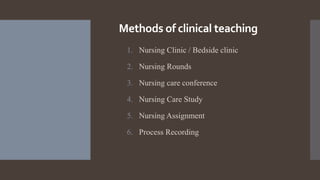CLINICAL TEACHING METHODS.ppt FOR NURSESx
- 1. CLINICALTEACHING METHODS Presented by: Priyanka Raj (MSC NURSING 1STYEAR)
- 2. Introduction ’é¢ In recent years, nursing education focused on theoretical education & deep gap between theoretical & clinical education created. ’é¢ Other than theoretical knowledge, imparting healthcare knowledge within the premises of healthcare facilities such as hospitals is also required. ’é¢ DEFINITION: ’é¢ Clinical teaching is an individualized or group teaching to the nursing student in the clinical area by the nurse educators, staff and clinical nurse manager.
- 3. Methods of clinical teaching 1. Nursing Clinic / Bedside clinic 2. Nursing Rounds 3. Nursing care conference 4. Nursing Care Study 5. Nursing Assignment 6. Process Recording
- 4. 1. BEDSIDE CLINIC ’é¢ It is a method of clinical teaching which is carried out by either the group visits the patient or the patient is brought to the conference room in order to study problems associated with a particular disease or disorder. ’é¢ Disease-centered teaching: This method is used to help student learn about a specific disease and similar patients are selected to show the sign and symptoms related to a particular condition. ’é¢ This is a teacher centered method. ’é¢ Meant for a small group of students. ’é¢ Disadvantage: May be demanding and burdensome to the patient.
- 5. 2. Nursing Rounds ’é¢ Nursing rounds is intended to discuss briefly the nursing management of all patients in the ward by sparing few minutes for each patient. ’é¢ The focus is to understand the NURSING-MANAGEMENT of multiple patients in a ward. ’é¢ The ideal duration of nursing rounds in a ward is 45 minutes and this time is sufficient to know about 20 to 25 patients. ’é¢ Demonstration of nursing care by senior members during the nursing rounds will help students to develop psychomotor skills and inculcate proper attitude among them.
- 6. NursingCare Conference ’é¢ It is same like a bedside clinic but the patient is not usually present for the class. ’é¢ It is a method of teaching which provides an opportunity for an informal discussion of a problem and free exchange of knowledge and experience about the common interest and it consists of a group discussion using problem solving techniques or nursing process. ’é¢ It can provide a good learning experience for all the staff who share a common nursing problem in providing care to a specific patient. ’é¢ A nursing care conference is designed around a consultation visit of a clinical nurse specialists.
- 7. NursingCare Study ’é¢ The student with the help of the clinical instructor selects one of her patients for intensive study which she finds interesting. ’é¢ The student must be given opportunity to take care of the patient over a long duration of time ’é¢ The student tries to solve the problems through the study, consultation and experimentation and decides the nursing measures which will meet the patientŌĆÖs individual needs and solve nursing problems.
- 8. Nursing Assignment ’é¢ It is that part of learning experience where students are assigned with patients or other activities concerning patients in the clinical laboratory. ’é¢ It is though the assignment that the teacher is able to arouse interest, stimulate right mental promotional attitudes & sets forth good study habits. ’é¢ Students are given facilities to practice nursing according to previous teachings.
- 9. Process Recording ’é¢ Process recording is an exact written report of the conversation between the nurse and the patient during the time they were together. ’é¢ It helps to develop communication and interviewing skill of students and also establishes therapeutic communication between student nurse and patient. ’é¢ The patientŌĆÖs identification data, presenting complain, etc are recorded. ’é¢ The written recording is evaluated as a learning experience at the end feedback is shared.
- 10. ’āś Learning by doing is the most effective method of teaching. The laboratory of the nursing students is the clinical field. ’āś The nursing students get the practical experience and skill doing procedures by taking care of the patients. ’āś The nurse manager plays a dual role, she is aware of the practical problems, and she should use each and every opportunity to teach the nursing students.
- 11. Bibliography 1. ŌĆ£Clinical Teaching Strategies in NURSINGŌĆØ, Kathleen B. Gaberson, Marilyn H.Oermann, 3rd edition, Springer Publishing Company. 2. ŌĆ£Fast factors for the clinicaL nursing instructorsŌĆØ, Eden Zabat Kan, Susan Stabler-Hass, Springer Publishing Company, New York. 3. ŌĆ£Virtual Learning EnvironmentsŌĆØ, Pierre. DilIenbourg, University of Geneva, EUN Conference 2000. 4. Education for Health, Vol.17, No.2, July 2004,236-39
- 12. THANKYOU











